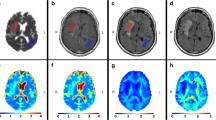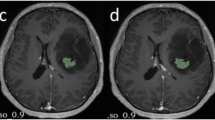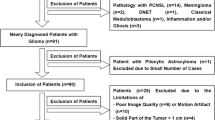Abstract
Introduction
Few studies have applied diffusion kurtosis imaging (DKI) and diffusion tensor imaging (DTI) for the comprehensive assessment of gliomas [tumour grade, isocitrate dehydrogenase-1 (IDH-1) mutation status and tumour proliferation rate (Ki-67)]. This study describes the efficacy of DKI and DTI to comprehensively evaluate gliomas, compares their results.
Methods
Fifty-two patients (18 females; median age, 47.5 years) with pathologically proved gliomas were prospectively included. All cases underwent DKI examination. DKI (mean kurtosis: MK, axial kurtosis: Ka, radial kurtosis: Kr) and DTI (mean diffusivity: MD, fractional anisotropy: FA) maps of each metric was derived. Three ROIs were manually drawn.
Results
MK, Ka, Kr and FA were significantly higher in HGGs than in LGGs, whereas MD was significantly lower in HGGs than in LGGs (P < 0.01). ROC analysis demonstrated that MK (specificity: 100% sensitivity: 79%) and Ka (specificity: 96% sensitivity: 82%) had the same and highest (AUC: 0.93) diagnostic value. Moreover, MK, Ka, and Kr were significantly higher in grade III than II gliomas (P ≦ 0.01). Further, DKI and DTI can significantly identify IDH-1 mutation status (P ≦ 0.03). Ka (sensitivity: 74%, specificity: 75%, AUC: 0.72) showed the highest diagnostic value. In addition, DKI metrics and MD showed significant correlations with Ki-67 (P ≦ 0.01) and Ka had the highest correlation coefficient (rs = 0.72).
Conclusions
Compared with DTI, DKI has great advantages for the comprehensive assessment of gliomas. Ka might serve as a promising imaging index in predicting glioma grading, tumour cell proliferation rate and IDH-1 gene mutation status.




Similar content being viewed by others
References
Ostrom QT, Gittleman H, Fulop J, Liu M, Blanda R, Kromer C, Wolinsky Y, Kruchko C, Barnholtz-Sloan JS (2015) CBTRUS statistical report: primary brain and central nervous system tumors diagnosed in the United States in 2008–2012. Neuro Oncol 17:v1–v62. https://doi.org/10.1093/neuonc/nov189
Siegal T (2016) Clinical relevance of prognostic and predictive molecular markers in gliomas. Adv Technol Stand Neurosurg 43:91–108. https://doi.org/10.1007/978-3-319-21359-04
Louis DN, Perry A, Reifenberger G, von Deimling A, Figarella-Branger D, Cavenee WK, Ohgaki H, Wiestler OD, Kleihues P, Ellison DW (2016) The 2016 World Health Organization classification of tumors of the central nervous system: a summary. Acta Neuropathol 131:803–820. https://doi.org/10.1007/s00401-016-1545-1
Hartmann C, Hentschel B, Wick W, Capper D, Felsberg J, Simon M, Westphal M, Schackert G, Meyermann R, Pietsch T, Reifenberger G, Weller M, Loeffler M, von Deimling A (2010) Patients with IDH1 wild type anaplastic astrocytomas exhibit worse prognosis than IDH1-mutated glioblastomas, and IDH1 mutation status accounts for the unfavorable prognostic effect of higher age: implications for classification of gliomas. Acta Neuropathol 120:707–718. https://doi.org/10.1007/s00401-010-0781-z
van den Bent MJ, Hartmann C, Preusser M, Ströbel T, Dubbink HJ, Kros JM, von Deimling A, Boisselier B, Sanson M, Halling KC, Diefes KL, Aldape K, Giannini C (2013) Interlaboratory comparison of IDH mutation detection. J Neurooncol 112:173–178. https://doi.org/10.1007/s11060-013-1056-z
Weiler M, Wick W (2012) Molecular predictors of outcome in low-grade glioma. Curr Opin Neurol 25:767–773. https://doi.org/10.1097/WCO.0b013e32835a0217
Habberstad AH, Gulati S, Torp SH (2011) Evaluation of the proliferation markers Ki-67/MIB-1, mitosin, survivin, pHH3, and DNA topoisomerase IIalpha in human anaplastic astrocytomas—animmunohistochemical study. Diagn Pathol 24:6:43. https://doi.org/10.1186/1746-1596-6-43
Donato V, Papaleo A, Castrichino A, Banelli E, Giangaspero F, Salvati M, Delfini R (2007) Prognostic implication of clinical and pathologic features in patients with glioblastoma multiforme treated with concomitant radiation plus temozolomide. Tumori 93:248–256
McGirt MJ, Woodworth GF, Coon AL, Frazier JM, Amundson E, Garonzik I, Olivi A, Weingart JD (2005) Independent predictors of morbidity after image-guided stereotactic brain biopsy: a risk assessment of 270 cases. J Neurosurg 102:897–901. https://doi.org/10.3171/jns.2005.102.5.0897
Romano A, Calabria LF, Tavanti F, Minniti G, Rossi-Espagnet MC, Coppola V, Pugliese S, Guida D, Francione G, Colonnese C, Fantozzi LM, Bozzao A (2013) Apparent diffusion coefficient obtained by magnetic resonance imaging as a prognostic marker in glioblastomas: correlation with MGMT promoter methylation status. Eur Radiol 23:513–520. https://doi.org/10.1007/s00330-012-2601-4
Ahn SS, Shin NY, Chang JH, Kim SH, Kim EH, Kim DW, Lee SK (2014) Prediction of methylguanine methyltransferase promoter methylation in glioblastoma using dynamic contrast-enhanced magnetic resonance and diffusion tensor imaging. J Neurosurg 121:367–373. https://doi.org/10.3171/2014.5.JNS132279
Moon WJ, Choi JW, Roh HG, Lim SD, Koh YC (2012) Imaging parameters of high grade gliomas in relation to the MGMT promoter methylation status: the CT, diffusion tensor imaging, and perfusion MR imaging. Neuroradiology 54:555–563. https://doi.org/10.1007/s00234-011-0947-y
Wu EX, Cheung MM (2010) MR diffusion kurtosis imaging for neural tissue characterization. NMR Biomed 23:836–848. https://doi.org/10.1002/nbm.1506
Hui ES, Cheung MM, Qi L, Wu EX (2008) Towards better MR characterization of neural tissues using directional diffusion kurtosis analysis. Neuroimage 42:122–134. https://doi.org/10.1016/j.neuroimage.2008.04.237
Van Cauter S, Veraart J, Sijbers J, Peeters RR, Himmelreich U, De Keyzer F, Van Gool SW, Van Calenbergh F, De Vleeschouwer S, Van Hecke W, Sunaert S (2012) Gliomas: diffusion kurtosis MR imaging in grading. Radiology 263:492–501. https://doi.org/10.1148/radiol.12110927
Kickingereder P, Sahm F, Radbruch A, Wick W, Heiland S, A Deimling, Bendszus M, Wiestler B (2015) IDH mutation status is associated with a distinct hypoxia/angiogenesis transcriptome signature which is non-invasively predictable with rCBV imaging in human glioma. Sci Rep 5:16238. https://doi.org/10.1038/srep16238
Lee S, Choi SH, Ryoo I, Yoon TJ, Kim TM, Lee SH, Park CK, Kim JH, Sohn CH, Park SH, Kim IH (2015) Evaluation of the microenvironmental heterogeneity in high-grade gliomas with IDH1/2 gene mutation using histogram analysis of diffusion-weighted imaging and dynamic-susceptibility contrast perfusion imaging. J Neurooncol 121:141–150. https://doi.org/10.1007/s11060-014-1614-z
Xiong J, Tan WL, Pan JW, Wang Y, Yin B, Zhang J, Geng DY (2016) Detecting isocitrate dehydrogenase gene mutations in oligodendroglial tumors using diffusion tensor imaging metrics and their correlations with proliferation and microvascular density. J Magn Reson Imaging 43:45–54. https://doi.org/10.1002/jmri.24958
Hempel JM, Bisdas S, Schittenhelm J, Brendle C, Bender B, Wassmann H, Skardelly M, Tabatabai G, Vega SC, Ernemann U, Klose U (2017) In vivo molecular profiling of human glioma using diffusion kurtosis imaging. J Neurooncol 131:93–101. https://doi.org/10.1007/s11060-016-2272-0
Hempel JM, Schittenhelm J, Brendle C, Bender B, Bier G, Skardelly M, Tabatabai G, Castaneda Vega S, Ernemann U, Klose U (2017) Histogram analysis of diffusion kurtosis imaging estimates for in vivo assessment of 2016 WHO glioma grades: a cross-sectional observational study. Eur J Radiol 95:202–211. https://doi.org/10.1016/j.ejrad.2017.08.008
Jiang R, Jiang J, Zhao L, Zhang J, Zhang S, Yao Y, Yang S, Shi J, Shen N, Su C, Zhang J, Zhu W (2015) Diffusion kurtosis imaging can efficiently assess the glioma grade and cellular proliferation. Oncotarget 6:42380–42393. https://doi.org/10.18632/oncotarget.5675
Alexiou GA, Zikou A, Tsiouris S, Goussia A, Kosta P, Papadopoulos A, Voulgaris S, Kyritsis AP, Fotopoulos AD, Argyropoulou MI (2014) Correlation of diffusion tensor, dynamic susceptibility contrast MRI and (99 m) Tc-Tetrofosmin brain SPECT with tumour grade and Ki-67 immunohistochemistry in glioma. Clin Neurol Neurosurg 116:41–45. https://doi.org/10.1016/j.clineuro.2013.11.003
Basser PJ (1995) Inferring microstructural features and the physiological state of tissues from diffusion-weighted images. NMR Biomed 8:333–344. https://doi.org/10.1002/nbm.1940080707
Jensen JH, Helpern JA, Ramani A, Lu H, Kaczynski K (2005) Diffusional kurtosis imaging: the quantification of non-gaussian water diffusion by means of magnetic resonance imaging. Magn Reson Med 53:1432–1440. https://doi.org/10.1002/mrm.20508
Kleihues P, Soylemezoglu F, Schäuble B, Scheithauer BW, Burger PC (1995) Histopathology, classification, and grading of gliomas. Glia 15:211–221. https://doi.org/10.1002/glia.440150303
Popov S, Jury A, Laxton R, Doey L, Kandasamy N, Al-Sarraj S, Jürgensmeier JM, Jones C (2013) IDH1-associated primary glioblastoma in young adults displays differential patterns of tumour and vascular morphology. PLoS ONE 8:e56328. https://doi.org/10.1371/journal.pone.0056328
Zhao J, Li JB, Wang JY, Wang YL, Liu DW, Li XB, Song YK, Tian YS, Yan X, Li ZH, He SF, Huang XL, Jiang L, Yang ZY, Chu JP (2018) Quantitative analysis of neurite orientation dispersion and density imaging in grading gliomas and detecting IDH-1 gene mutation status. NeuroImage 19:174–181. https://doi.org/10.1016/j.nicl.2018.04.011
White NS, McDonald CR, Farid N, Kuperman JM, Kesari S, Dale AM (2013) Improved conspicuity and delineation of high-grade primary and metastatic brain tumors using “restriction spectrum imaging”: quantitative comparison with high B-value DWI and ADC. AJNR Am J Neuroradiol 34:958–964.
Cha S (2006) Update on brain tumor imaging: from anatomy to physiology. AJNR Am J Neuroradiol 27:475–487
Cai J, Zhang C, Zhang W, Wang G, Yao K, Wang Z, Li G, Qian Z, Li Y, Jiang T, Jiang C (2016) ATRX, IDH1-R132H and Ki-67 immunohistochemistry as a classification scheme for astrocytic tumors. Oncoscience 3:258–265. https://doi.org/10.18632/oncoscience.317.eCollection2016
Funding
This study was funded by National Natural Science Foundation of China (CN) (Grant No. 81201074) and Fundamental Research Funds for the Central Universities (Grant No. 13ykpy14).
Author information
Authors and Affiliations
Corresponding author
Ethics declarations
Conflict of interest
The authors declare that they have no conflict of interest.
Ethical approval
This study was approved by the Research Ethics Committee of the First Affiliated Hospital of Sun Yat-sen University according to the ethical guidelines for human research and is compliant with the Health Insurance Portability and Accountability Act (HIPAA).
Informed consent
Written informed consent was obtained from adult patients or their legal guardians.
Rights and permissions
About this article
Cite this article
Zhao, J., Wang, Yl., Li, Xb. et al. Comparative analysis of the diffusion kurtosis imaging and diffusion tensor imaging in grading gliomas, predicting tumour cell proliferation and IDH-1 gene mutation status. J Neurooncol 141, 195–203 (2019). https://doi.org/10.1007/s11060-018-03025-7
Received:
Accepted:
Published:
Issue Date:
DOI: https://doi.org/10.1007/s11060-018-03025-7




